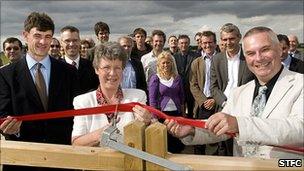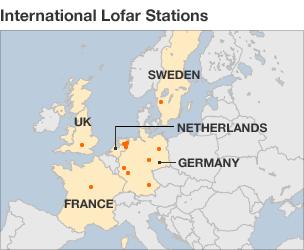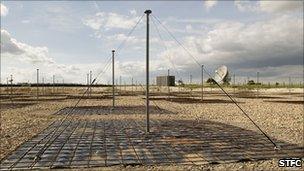Telescope goes after first stars
- Published

Pulsar discoverer Dame Jocelyn Bell Burnell performs the official opening at Chilbolton
The UK has officially opened its first station in a new international radio astronomy antenna network.
Lofar (Low Frequency Array) is a European project that incorporates new digital techniques to survey wide areas of the sky all at once.
The station in Chilbolton, Hampshire, joins similar sites in France, Germany, Sweden and the Netherlands.
Astronomers hope the network can help them probe the period in cosmic history when the very first stars were formed.
"In traditional arrays, you have to move their dishes physically if they want to look in a different direction," explained Derek McKay-Bukowski, the project manager at Lofar Chilbolton.
"Lofar is a digital telescope which means you can switch the direction where you're looking very fast. You can go from one side of the sky to the other side of the sky - rather than in minutes, you can do it milliseconds. And because it's digital, Lofar can look in multiple directions at once," he told BBC News.
Lofar is sensitive to much longer wavelength radiation than the UK's established radio telescope array called Merlin, which is based on the giant Lovell dish at Jodrell Bank in Cheshire.
Being able to detect this particular segment (1-10m/240-30MHz) of the electromagnetic spectrum will enable scientists to study very different astrophysical phenomena.
One key target is the epoch of re-ionisation.
This relates to an important change in the cosmic environment brought about by the very first population of stars to shine in the Universe.
Theory holds these hot, young giants produced intense ultraviolet radiation that "fried" the neutral gas that had formed up to that point and which we detect in the local Universe today as a diffuse plasma between the galaxies.

Seeing this first population of stars is just beyond the capability of the current crop of optical telescopes like Hubble or the VLT, but conditions during this epoch could be probed at Lofar frequencies, astronomers say.
The network plans to install more and more antennas over the years to make Lofar ever more sensitive to what it is trying to see.
Derek McKay-Bukowski said: "When the entire project is finished, we will have something in the order of 5,000 antennas for both low-band and high-band, which will be located at about 48 stations across Europe.
"The biggest separation is about 1,100km. Distance between stations gives you resolution; to see finer detail you need bigger and bigger separations."
Lofar is led by Astron (the Netherlands Foundation for Research in Astronomy) which is installing a dense network of antennas centred near the village Exloo in the north of Halland.

The Chilbolton Observatory's low-band antennas
Lofar UK is funded through a collaboration of UK universities with the SEPnet consortium and the UK Science and Technologies Facilities Council.
As well as re-ionisation, the project has five other major research areas:
1. Surveying space beyond our galaxy to try to understand the history of star formation and black hole growth over cosmological time
2. Probing the extreme astrophysical environments that lead to transient bright bursts in the radio sky, such as from pulsars, the highly magnetised remains of dead stars
3. Understanding cosmic rays, the storm of high-energy particles (mostly protons and helium nuclei) that rain down on Earth
4. Studying the local space environment, to see how the wind of particles billowing away from the Sun interacts with the Earth.
5. Investigating cosmic magnetism - the origin of the large-scale fields that pervade the Universe.